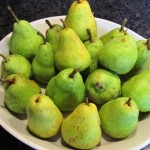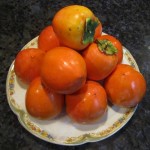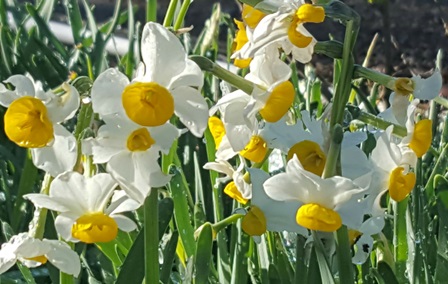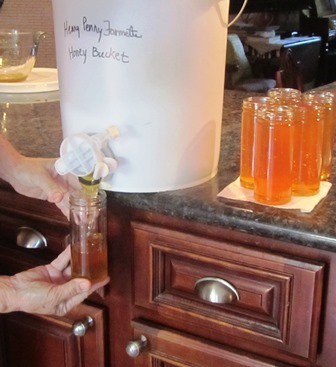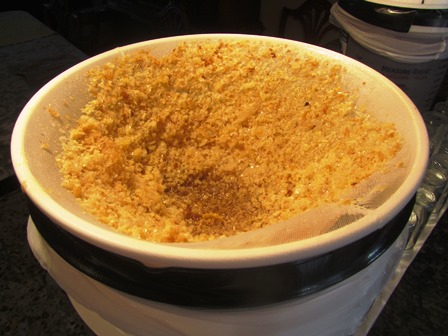The Fall “P” Fruits Are Ripening on the Farmette
Our pears, persimmons, and pomegranates hang heavy on the trees now. This despite the scorching summer we’ve had and the lack of rain. Water restrictions have made it doubly difficult for the fruits of these trees to reach their full potential.
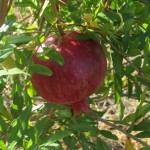
Ripe pomegranates have a leathery outer skin, membranes thicker than oranges, but sweet, juicy seeds inside
The squirrels and raccoons have been munching on the late summer pears. Yesterday, I stripped most of the fruit off and placed in paper bags in the kitchen cabinet. In two to three days, the pears will reach the perfect ripeness for eating fresh.
Fuju and hachiya persimmons are taking on color and should be ripe and ready to eat in about a month. I’ve been working hard to save the trees that are suffering from California’s extreme drought.
A spokesman for one Bay Area water resource board suggested we gardeners let our ornamental plants like roses and other flowers go while we try to save our trees. A hard thing for me to do. Praying for rain, we hold out hope that next year’s climate will be better for backyard gardeners and growers.
______________________________________________________________________________
Interested in backyard gardening topics like keeping chickens and bees or growing heirloom vegetables? Check out my cozy mystery series from Kensington. The stories are informed by my work on the farmette I’ve been restoring for a dozen years. Find all Meera Lester books on Amazon.com, Barnesandnoble.com, and everywhere books are sold online or in brick and mortar stores.
Beeline to Murder features a former cop who keeps bees
and sells lavender honey to her town’s celebrity chef . . . until
she finds him dead.

The town of Las Flores is abuzz with the news of the death of a free spirit who has secrets in her background and ties to a local nudist camp.

The renewal of wedding vows ends on the steps of the church with the outburst of a local woman intent on revenge. The husband is soon found dead but the obvious suspect may not be the culprit at all.
Critter-proofing Your Bulbs
I planted bagfuls of tulips, daffodils, crocus, and grape hyacinths over the last two years in the autumn. The daffodils are blooming now and the other bulbs in my garden have plenty of foliage.
Because voles, moles, gophers, squirrels, raccoons, and other critters will dig and eat the bulbs and deer will devour the blooms at first blush of color, a savvy gardener must figure out how to protect these beautiful flowers.
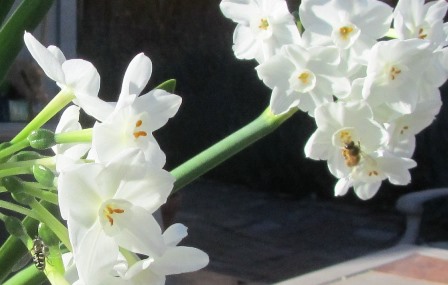
The bees are drawn to the sweet scent of narcissus that have now naturalized in my Henny Penny Farmette gardens
Throughout the Midwest of my youth, hillsides, front yards, and cemeteries were always places where daffodils grew in perfusion. Along with the arrival of robins and other songbirds, these flowering bulbs herald the coming light and warmth of spring. I’ve lost plenty of these plantings myself so have some tips to help you prevent such a loss.
Seven ways to protect flowering bulbs.
1. Grow them behind a double fence barrier. Deer can jump high and might go over one fence, but not a second one built near the first.
2. Use mesh to deter moles, voles, gophers, groundhogs, and other digging critters.
3. Erect fences that are at least three feet tall and with at least a foot buried beneath the earth.
4. Plant in raised beds covered with mesh. The bulbs will be protected while the foliage and blooms poke through toward the light.
5. Clean up the area in the fall after planting the bulbs. That way, critters won’t be attracted to your bulb beds.
6. Consider using deer-repellent sprays on tulips and growing deer-resistant bulbs.
7. Use ammonia-soaked rags in coffee cans or old planting buckets around the garden to repel pests with a keen sense of smell such as rabbits and opossums.
* * *
Enjoy reading about farming topics? Check out my cozy mysteries–A BEELINE TO MURDER and also THE MURDER OF A QUEEN BEE (both in the Henny Penny Farmette series from Kensington Publishing). Kobo Books has A BEELINE TO MURDER on sale. Check out this incredible deal on https://www.kobo.com/us/en/search?Query=Meera+Lester
My farmette and bee-based novels are chocked full of recipes, farming tips, chicken and beekeeping tips, sayings and, of course, a charming cozy mystery. For more info, click on the links under the pictures.
The books are available through online retailers such as Amazon, Barnes & Noble, Target, BAM, Kobo Books, and Walmart as well as from traditional bookstores everywhere.
See, http://tinyurl.com/hxy3s8q
A Beeline to Murder is the debut novel that launched the Henny Penny Farmette series of mysteries. Initially released as a hardcover novel and in e-book format, it is now available as a mass market paperback.
See, http://tinyurl.com/h4kou4g
NEWLY RELEASED! This, the second cozy mystery in the Henny Penny Farmette series, is garnering great reviews from readers and industry publications.
Gifts from the Hive
Mention beekeeping, and most folks think right away of the delicious honey that bees make. Of course, farmers and gardeners love bees because the insects pollinate the plants growing in the vicinity of their hives.
After collecting pollen, the bees make honey–nature’s sweetener. Honey adds an interesting flavor to savory dishes and is a valued ingredient in desserts. Raw honey also has medicinal value since it has a slightly acidic pH and can cause a complex reaction when used to disinfect scrapes and wounds. But honey has other uses as well.
Because honey contains lower levels of fructose (unlike refined sugars), it is less inflammatory to the stomach and digestive organs. Today, honey is widely considered a superfood, one to be consumed to maintain good health. Honey is a great ingredient for cough drops and sore throat soothers. Or, drop a spoonful into your favorite tea for a cupful of enjoyment at any time.
Comprised of tiny particles of powdery pollen gathered from flowers, bee pollen is loaded with vitamins and minerals. It also contains amino acids, enzymes, and proteins. It can be eaten in foods or on cereal as well as used as an ingredient in soap.
Beeswax makes lovely candles and soaps. Honey is often used as a vital ingredient in homemade cosmetics, bath oils, and hand cream. Of course, all these gifts from the hive are as appreciated by those who don’t keep bees as well as those who do. And since the season of gift-giving is upon us, consider buying from local beekeepers their artisanal honey and other products from the hive.
 Facebook
Facebook Goodreads
Goodreads LinkedIn
LinkedIn Meera Lester
Meera Lester Twitter
Twitter



